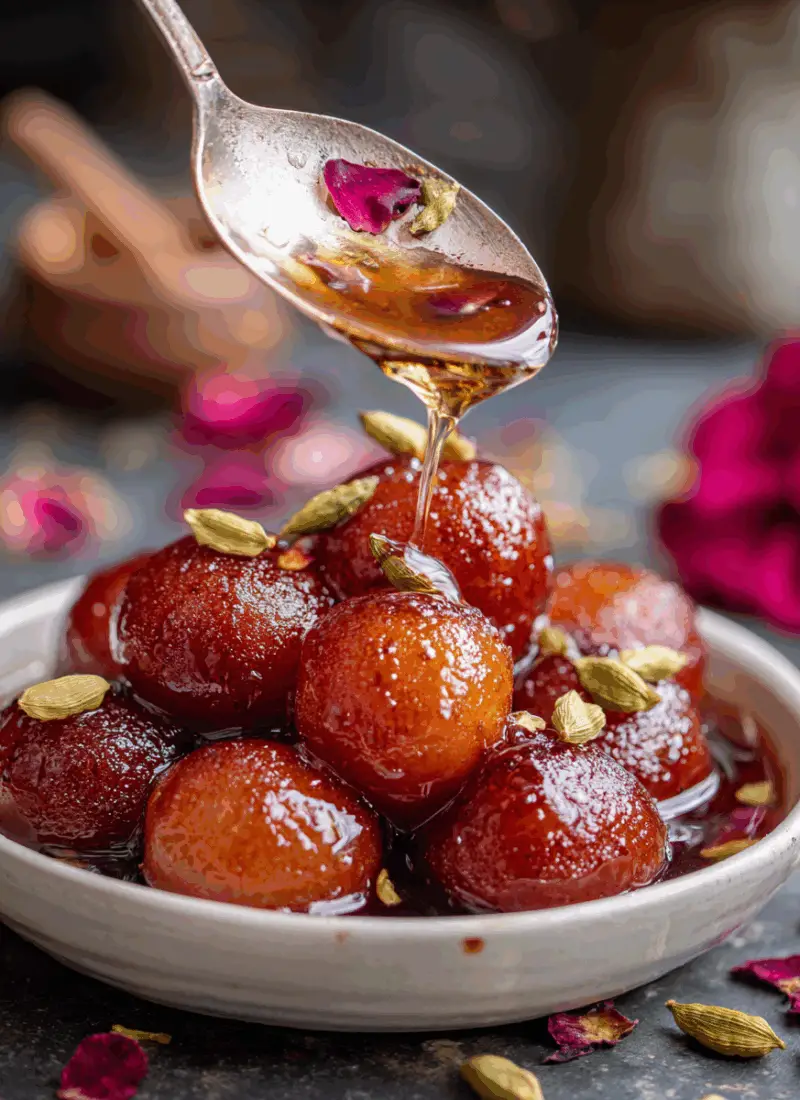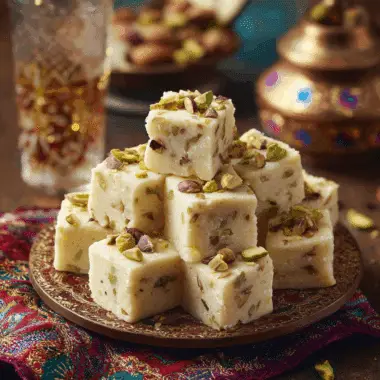Gulab Jamun is a classic Indian dessert beloved across South Asia and beyond, known for its melt-in-your-mouth texture and irresistible sweetness. These golden brown milk-based balls are soaked in fragrant rose-cardamom syrup, making them perfect for festive occasions, family gatherings, or just a sweet treat at home. Traditionally made with khoya (milk solids), this homemade version simplifies the process using milk powder while still delivering soft, juicy, and indulgent results.
FULL RECIPE
Ingredients
1.For the Gulab Jamun Dough:
- 1 cup milk powder
- 1/4 cup all-purpose flour
- 1/4 tsp baking soda
- 2 tbsp ghee (clarified butter)
- 1/4 cup milk (warm, adjust as needed)
- Ghee or oil (for deep frying)
2.For the Sugar Syrup:
- 1 1/2 cups granulated sugar
- 1 1/2 cups water
- 4 green cardamom pods (slightly crushed)
- 1 tsp rose water or 1/2 tsp rose essence
- A few saffron strands (optional)
- 1/2 tsp lemon juice (to prevent crystallization)
Directions
- Prepare the sugar syrup: In a medium saucepan, combine sugar, water, and cardamom. Heat over medium flame, stirring occasionally until the sugar dissolves. Once it starts to simmer, add lemon juice, saffron, and rose water. Let it simmer for 5–6 minutes, then turn off the heat and set aside. Keep the syrup warm but not boiling.
- Make the dough: In a mixing bowl, add milk powder, flour, and baking soda. Mix dry ingredients well. Add ghee and gently rub it into the mixture using your fingers until crumbly.
- Form the dough: Gradually add warm milk, 1 tbsp at a time, mixing gently to form a soft, sticky dough. Avoid kneading. Let it rest for 5–10 minutes covered with a moist cloth.
- Shape the balls: Apply a little ghee on your palms and divide the dough into 12–15 small portions. Roll gently into smooth, crack-free balls. Don’t press hard while shaping.
- Heat the oil or ghee: In a deep pan, heat oil or ghee on low-medium heat. Test by dropping a small piece of dough—it should slowly rise and not brown immediately.
- Fry the Gulab Jamun: Fry the dough balls in batches. Stir gently and continuously to ensure even browning. Fry until golden brown (this takes about 6–8 minutes per batch).
- Soak in syrup: Once fried, drain excess oil and immediately place the hot Gulab Jamun into the warm syrup. Let them soak for at least 1–2 hours to absorb flavors fully.
- Serve: Enjoy warm or chilled, garnished with slivered almonds or pistachios if desired.
Nutrition Facts
- Calories: 180 kcal
- Carbohydrates: 28 g
- Protein: 3 g
- Fat: 7 g
- Saturated Fat: 4 g
- Cholesterol: 15 mg
- Sodium: 50 mg
- Potassium: 80 mg
- Sugar: 20 g
- Calcium: 10% of Daily Value
- Iron: 2% of Daily Value
Cultural Significance of Gulab Jamun
Gulab Jamun holds a revered place in South Asian cuisine, particularly in Indian, Pakistani, Bangladeshi, and Nepali cultures. It’s a dessert that signifies celebration and is often present at weddings, religious festivals like Diwali and Eid, and family gatherings. The name itself—‘Gulab’ meaning rose and ‘Jamun’ referring to a dark purple berry native to India—reflects its traditional essence. Its origins trace back to Persian and Mughal influences, making it not only a treat for the palate but also a historical culinary artifact that bridges cultures and generations.
Texture and Flavor Profile
What makes Gulab Jamun truly indulgent is its soft, melt-in-the-mouth texture coupled with a delicate balance of sweetness and aromatic flavor. The dough, once fried, turns golden-brown and develops a slight crispness on the outside, while the inside remains pillowy and tender. When soaked in rose-scented sugar syrup infused with cardamom and saffron, the flavors seep in completely, resulting in a juicy, aromatic dessert. It’s this contrast—lightly chewy exterior and syrup-drenched interior—that makes each bite unforgettable.
Nutritional Overview
While Gulab Jamun is undeniably rich, it’s helpful to understand its nutritional composition for mindful consumption. Each piece is high in carbohydrates and sugars due to the syrup and milk powder base, providing a quick energy boost. It also contains moderate amounts of protein and fat. Calcium from the dairy components supports bone health, and the cardamom and saffron add not just flavor but small antioxidant benefits. However, because of its high sugar content, it is best enjoyed in moderation as an occasional treat rather than a regular indulgence.
Popular Variations
Gulab Jamun has evolved over time with regional and modern variations adding exciting twists. Kala Jamun, for example, is a darker version fried longer for a slightly denser texture and often filled with dry fruits. Some recipes incorporate khoya (milk solids) for a more traditional taste, while others experiment with paneer or even sweet potatoes. Contemporary versions might include chocolate-stuffed Gulab Jamun or those served with flavored syrups like orange blossom or lavender, giving this timeless dessert a modern makeover while retaining its essence.
Serving Suggestions
Gulab Jamun can be served in various ways depending on the occasion and personal preference. Traditionally, it is served warm, allowing the syrup to be enjoyed at its aromatic best. For festive buffets or formal meals, plating the Gulab Jamun with a drizzle of extra syrup and garnishing with chopped pistachios or edible silver leaf can enhance presentation. In modern interpretations, it may be paired with vanilla ice cream or even served atop a brownie for fusion-style desserts. No matter how it’s served, it always adds a luxurious touch to any table.
Pairings and Beverage Complements
Pairing Gulab Jamun with complementary beverages enhances the overall dessert experience. A cup of hot masala chai balances the sweetness with its spiced, tannic notes, while a mildly sweet lassi complements the rich dairy flavors. Some gourmet experiences even pair Gulab Jamun with dessert wines like Moscato or sweet Rieslings, which align well with the syrup’s flavor profile. On the savory side, after a spicy biryani or rich curry meal, Gulab Jamun acts as the perfect cooling, sweet finish.
Storage and Shelf Life
Proper storage of Gulab Jamun helps maintain its texture and flavor for several days. Once prepared, it can be kept at room temperature for up to 24 hours if consumed quickly. For longer storage, refrigeration is recommended, where it can stay fresh for 4–5 days. Store it in an airtight container, submerged in syrup to prevent drying. When ready to serve again, gently warm the syrup and the balls on the stovetop or microwave to revive their softness and flavor. Avoid freezing, as it alters the texture and makes the balls rubbery.
Tips for Perfect Texture
Achieving the ideal Gulab Jamun texture requires careful attention to dough handling and frying technique. Over-kneading the dough can make the balls tough, while under-kneading leads to cracks. Use warm milk to make a soft, sticky dough and allow it to rest briefly. When frying, ensure the oil is on low to medium heat; if too hot, the outside browns too quickly while the inside remains raw. Constant gentle stirring ensures even coloring. Finally, make sure the syrup is warm, not hot, when soaking, to allow full absorption without breaking the balls.
Making it Vegan or Healthier
Though traditionally made with dairy, Gulab Jamun can be adapted to suit vegan diets. Substitute the milk powder with coconut or almond milk powder, ghee with vegan butter or coconut oil, and regular milk with a plant-based option. For a healthier twist, natural sweeteners like jaggery syrup or agave can replace refined sugar in the syrup, though the flavor will slightly vary. Baking instead of frying is another approach, though it won’t yield the same traditional texture. These alternatives help cater to dietary preferences without sacrificing the joy of enjoying this classic dessert.
Kids and Family-Friendly Appeal
Gulab Jamun is widely adored by people of all ages, making it a go-to family dessert. Children are often drawn to its soft, sweet nature and love helping with simple tasks like rolling the dough balls or garnishing. Involving kids in the process not only fosters appreciation for cultural cooking but also makes for a fun kitchen activity. For birthday parties or family celebrations, mini Gulab Jamuns served in individual cups or skewered for easy handling can make it more accessible and visually appealing to younger guests.
Conclusion
Homemade Gulab Jamun is more than just a dessert—it’s a symbol of warmth, tradition, and shared celebration. With its aromatic syrup and soft, syrup-laden balls, it offers a rich sensory experience that connects generations and cultures. Whether you stick to the classic version or try modern twists, mastering this recipe at home opens the door to endless sweet memories. From festive tables to casual indulgence, Gulab Jamun continues to charm and comfort with every bite.








